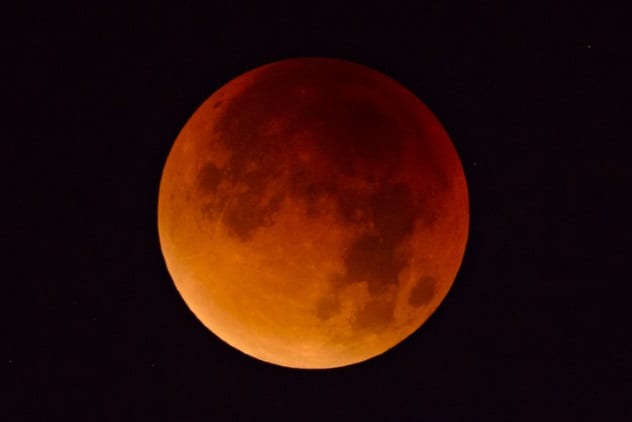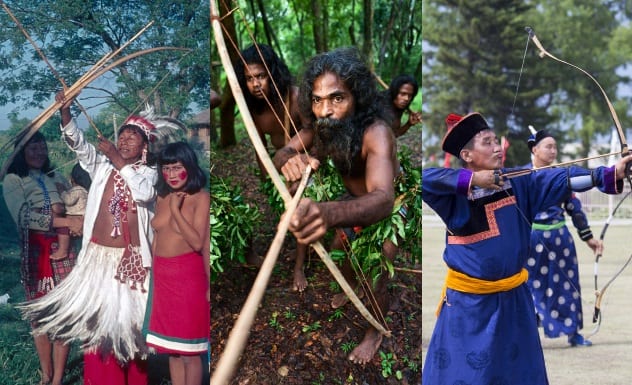 Our World
Our World  Our World
Our World  Pop Culture
Pop Culture 10 Incredible Female Comic Book Artists
 Crime
Crime 10 Terrifying Serial Killers from Centuries Ago
 Technology
Technology 10 Hilariously Over-Engineered Solutions to Simple Problems
 Miscellaneous
Miscellaneous 10 Ironic News Stories Straight out of an Alanis Morissette Song
 Politics
Politics 10 Lesser-Known Far-Right Groups of the 21st Century
 History
History Ten Revealing Facts about Daily Domestic Life in the Old West
 Weird Stuff
Weird Stuff 10 Everyday Products Surprisingly Made by Inmates
 Movies and TV
Movies and TV 10 Actors Dragged out of Retirement for One Key Role
 Creepy
Creepy 10 Lesser-Known Shapeshifter Legends from Around the World
 Our World
Our World 10 Science Facts That Will Change How You Look at the World
 Pop Culture
Pop Culture 10 Incredible Female Comic Book Artists
 Crime
Crime 10 Terrifying Serial Killers from Centuries Ago
Who's Behind Listverse?

Jamie Frater
Head Editor
Jamie founded Listverse due to an insatiable desire to share fascinating, obscure, and bizarre facts. He has been a guest speaker on numerous national radio and television stations and is a five time published author.
More About Us Technology
Technology 10 Hilariously Over-Engineered Solutions to Simple Problems
 Miscellaneous
Miscellaneous 10 Ironic News Stories Straight out of an Alanis Morissette Song
 Politics
Politics 10 Lesser-Known Far-Right Groups of the 21st Century
 History
History Ten Revealing Facts about Daily Domestic Life in the Old West
 Weird Stuff
Weird Stuff 10 Everyday Products Surprisingly Made by Inmates
 Movies and TV
Movies and TV 10 Actors Dragged out of Retirement for One Key Role
 Creepy
Creepy 10 Lesser-Known Shapeshifter Legends from Around the World
10 Things We All Surprisingly Do The Same
Humans are an incredibly diverse species, which is evident from the many differences between the multitude of cultures spread across the world. From different customs, ways of living, types of food, and languages, it’d be hard for an outside observer to ascertain that we’re the same creatures after all. Despite all these differences, though, there remain some things that we all do the same, no matter where we grew up.
These are the things that you wouldn’t expect to simultaneously develop in different parts of the world, especially if the cultures had no extensive contact with each other. They prove that even if humans are divided by so many things, there are still some things that we all share as a species.
10 Flutes

People who’ve professionally studied music know that various musical schools and styles around the world are vastly different from each other. They traditionally don’t take much from each other, and all the major ones still require training from scratch to get good at. Even the traditional musical instruments are different depending on where you are in the world, but there’s one instrument that is common throughout cultures in more or less the same form: the flute.
From the Persian ney and Indian bansuri to the Chinese dizi and the suspiciously unnamed Native American flutes, they all follow almost the same design throughout different musical traditions. Even if all of them are made of different materials (the Indian flute is made out of bamboo, whereas a Native American flute could be made from wood), they all look like they cheated on each other’s designs, despite the fact that all of them developed independently in different cultures. Even one of the oldest instruments ever found, which—you guessed it—was a flute, looks quite similar to flutes made today.[1]
9 Nodding

If you were to find yourself in a completely different country and culture you weren’t familiar with, you’d be in a dire situation, for one thing, as you clearly didn’t think this through. It would be difficult to ask for even the most basic things, unless you’re counting on your gesture-making skills to perform at the right time. But among all that confusion, there’s still one universal gesture you can count on even in the most remote parts of the world; nodding the head for a “yes” and shaking it for a “no” (well, except in Bulgaria and a handful of other places).
No one understands how this came to be the case, but it’s been known for a while that you can count on just about everyone to understand these basic gestures anywhere in the world. The nod isn’t just used for a “yes,” either; it’s also a universally accepted gesture for a bunch of other things, like acknowledgement or friendliness, and we haven’t found anyone from any country who doesn’t get that.[2] It may have to do with one of our ancestors being really into nodding, but it also may be due to humans literally being the same species.
8 Dragons

We all know that people were a bit on edge all the time when the world was a dangerous place to live in and found explanations in the supernatural for things they couldn’t explain with the tools of the time. There’s no dearth of mythological beings right out of your nightmares in the various mythologies of the world, and most of them depict the immediate issues of their respective historical days. They’re all quite different from each other, though, except one part that mysteriously overlaps: dragons.
Reptilian beasts that could fly and shoot fire (and ice, in case you aren’t clued in to Game of Thrones) are a recurring theme in the mythologies of cultures that shouldn’t have had any contact with each other until recently, from Scandinavia all the way to Japan.[3] Now, some of it could be explained by fossils; we found bones looking like a big reptile and figured that it must be the flying, fire-breathing creatures that inhabit that rumbling mountain. However, that doesn’t explain the almost uncannily similar general characteristics of dragons in different countries.
7 ‘Huh?’

Different cultures have different verbal and nonverbal gestures to quickly express an emotion, and a lot of them are dependent on how the culture developed and how fit the people were to physically pull it off (like complicated handshakes). They help us understand each other when we’re around our own people but break down if we have to communicate with someone who didn’t grow up with the same ones. There’s one verbal expression, however, that is the same in nearly all the languages and cultures of the world: the “huh.”
More of a sound than a word, everyone uses “huh” for the same thing, and everyone instinctively understands what it means no matter where they are in the world. This was confirmed by research done at the Max Planck Institute for Psycholinguistics in the Netherlands, which carried out a linguistic study to better understand how we communicate.[4] Because it’s so prevalent, it could have been carried over from our earlier ancestors.
6 The Moon

If we asked for your opinion on the Moon, the most surprising thing you could answer with is that you have one. Once a coveted place to go to for one-upmanship during the Cold War, the Moon now exists only as an afterthought. If there’s one thing we learned after going there a handful of times, it’s to never go there again because of how boring it is.
Ancient cultures, though, have been weirdly—and, for some reason, darkly—fascinated with the Moon. Where we see a calm celestial body periodically hung in the night sky, people in history associated the Moon with all kinds of bad things. That would be okay if it was just one culture, as people in history were kind of dumb, but the Moon shows up as something to be feared in almost all historical cultures.
A lunar eclipse, for example, was considered to be the absolute worst thing to happen across continents. Where the ancient Inca took that to mean that a huge jaguar was leaping at the Moon and would come to eat them once it was done with it, ancient Mesopotamians considered it to be a direct attack on the king.[5] (You can’t make these up.) Many other cultures saw a lunar eclipse to be an immensely ominous event, or at least something to feel sad about, even though lunar eclipses probably never actually did anything to deserve that reputation.
5 Dumplings

Nowhere is the sheer diversity of the human race more clear than in our food. Not only is it prepared differently depending on where you are in the world and the ingredients available there, but it’s also specialized to the nutritional needs of the populations that consume it. All of those factors come together to make food such an identifiable part of all our cultures. Except for some overlaps here and there due to the mixing of cultures, food items usually look very different in different countries.
One of the rare exceptions to that is the humble dumpling. From momo in Tibet to wonton in China to tortellini in Italy, we all have some version of the dumpling in our cultures, which is essentially dough wrapped into folds around locally available ingredients and cooked. While different variations of it exist, especially in the ingredients used to wrap inside, it’s more or less the same thing throughout. It’s also one of the oldest food items ever, which may explain why it’s so common across the world.[6]
4 Parts Of Language

Language is an intrinsic part of a culture, and the sheer diversity of languages to come out of the same species is truly astounding. Everyone has a distinct mother tongue with its own script, pronunciation, grammar, and all the complexities that make up a language, which is not a surprise, given how spread out human beings are around the world. Once we left Africa, it was pretty much “make up your own language because everyone is or you’d die out” for everyone.
The differences are plenty, so it’s a surprise when similar themes from different languages show up in others, even more so when the languages developed independently. Many names show up in seemingly different languages, even though they mean completely different things, along with other similarities.
In a study of around 6,000 languages, researchers found the sounds of many words to be too similar for comfort, and they also concluded that geographical proximity had nothing to do with it.[7] Many times, similarities were found in languages from countries spread across the map, suggesting that in some way, we all think about language in similar ways.
3 Bow And Arrow

In the ancient times, when the different regions hadn’t yet come into contact with each other, many weapons developed independently, driven by the local terrain and type of conflict. Many of those weapons never made it to other regions until very late (like horse cavalry, which is a rather recent phenomenon in European history), and often, those unique weapons were the deciding factors in the consistently shifting borders of history. Weapons were generally different around the world, except one that shows up in most military traditions: the bow.
If you’re thinking, “Sure, put a thread on a long piece of wood and you have a bow,” you’d be underestimating the procedure of making one. Finding the right type of wood, treating it properly, trial and error with strings until you find something strong enough: it wasn’t easy work for people in early history. And yet, bows show up in a similar form in almost all cultures, going as far back as the earliest periods of human civilization. In fact, some archaeologists found our earliest ancestors experimenting with different types of arrowheads, proving that the classic bow and arrow has been around for a while, which may explain why it’s so spread out.[8]
2 Folklore

Every culture has its own folklore and mythology; many of them interesting stories with important lessons, and many of them just depictions of scary monsters people were afraid of at the time. It’s also incredibly diverse depending on where you are, which is obvious, as most of the cultures were not in touch with each other while writing all of that down. What’s more surprising, however, is that despite the geographical and linguistic differences and any lack of contact, many similar themes show up in folklore around the world.
Take the half-serpent, half-human shape that shows up in a lot of Indian mythology. It also featured heavily—with similar characteristics—in ancient Chinese lore, as well as in the lore of a West African tribe called the Dogon. There are tons of similarities like that in seemingly different religions, like the Chinese and Hebrew creation and flood myths, well beyond what you may attribute to cultures influencing each other.[9]
1 Cinderella

“Cinderella,” also known as “The Little Glass Slipper,” is one of the most recognizable folktales in all of the Western world. There aren’t many who don’t know this story of hardship, love, and shoe sizes. What we all don’t realize is that it’s not just limited to the Western world; Cinderella is one of the oldest stories in the world and shows up with slight variations in many countries.
If we’re talking about known records, the story of Cinderella goes as far back as at least AD 850 in the form of a Chinese folktale called “Yeh-Shen.” It also features a girl living with parents who hate her and a magical creature who helps her get with the king at a ceremony. She also leaves a slipper behind that helps the king find her and eventually marry her. Other than the European setting of Cinderella, that’s essentially the same story.
That’s only the Chinese version and the one that we have known records for; the earliest Cinderella iteration may actually go as far back as 7 BC. Almost every culture has its own version of it, too, proving that no matter how different we are, our stories still follow the same patterns.[10]
Himanshu has written for Cracked, Modern Rogue, Screen Rant, and Forbes. Get in touch with him for writing gigs, or just say hello to him on Twitter.
Read more about the human species on 10 Disgusting Facts About The Human Mouth and 10 Fascinating Facts About The Human Skeleton.








